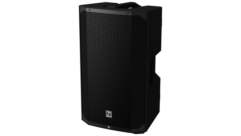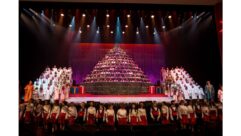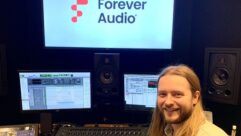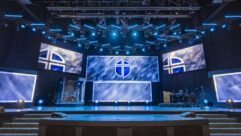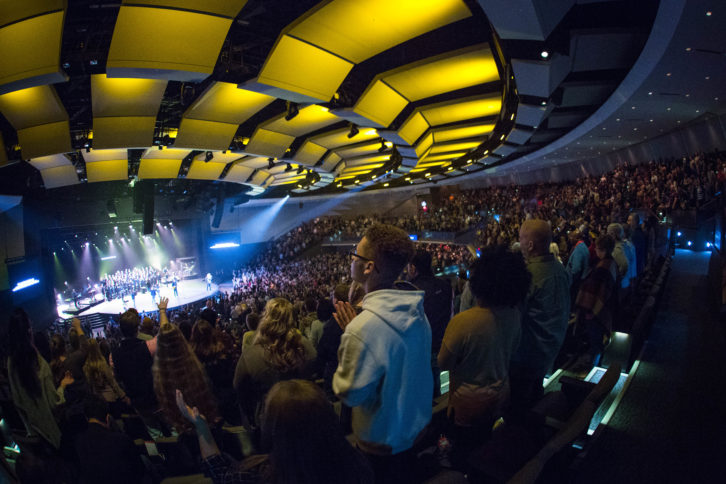
Gateway Church is ranked among the nation’s largest multisite congregations with an average of more than 30,000 worshippers weekly attending 29 weekly services at nine campuses — eight in the Dallas-Fort Worth area plus an extension campus in Wyoming.
Like many other contemporary churches, the Gateway Southlake auditorium is designed with wide, fan-shaped seating that wraps around the stage. Although this promotes a greater sense of intimacy, it challenges audio system design in general and, in particular, makes it difficult to maintain a stereo image while ensuring high intelligibility throughout the space.
The prior system based on Meyer Sound MILO line arrays was designed as an LCR mono configuration. For the recent upgrade at Gateway’s flagship Southlake campus, the 4,000-seat auditorium got 51 new Meyer Sound LEO Family loudspeakers configured as a novel mono-stereo “hybrid” system.
“This time we wanted to see if we could leverage the latest technology to open up our sound with a stereo feel for most of the congregation while still maintaining excellent intelligibility and without the effect being distracting to anyone,” says Brandon Conn, Gateway Senior Audio Engineer for Live Production. “We had already upgraded some of our satellite campuses to LEOPARD line arrays, so we were confident that the clarity and control of the LEO Family would help us achieve this goal.”
The new system was designed and engineered as a collaborative effort by Gateway Church audio staff, Meyer Sound Director of System Optimization Bob McCarthy, and system integrator Pro Sound & Video (a Solotech company). On-site installation was supervised by Pro Sound & Video’s Shaun Philips, assisted by TJ Volts, under the direction of company CEO Rod Sintow.
The eventual solution was to deploy three hangs of five-each LEOPARD line array loudspeakers aimed to cover the first ten rows of seating, all carrying a mono signal. The main center section with the great majority of seats is covered in stereo by left and right arrays each with five LYON-M main over six LYONW wide coverage line array loudspeakers.
“The idea here was to create a stereo image where it works well, but not attempt it where it would compromise performance or intelligibility,” comments McCarthy. “Up front, a split left and right would be so wide it would pull you away from the stage. So there, a mono image reinforces an intimate connection with the stage, then from row 11 back it blends seamlessly into a more open stereo image.”
To assure uniform frequency response front-to-back in the field of the main arrays, McCarthy implemented Meyer Sound’s new Low-Mid Beam Control (LMBC) in the tuning process.
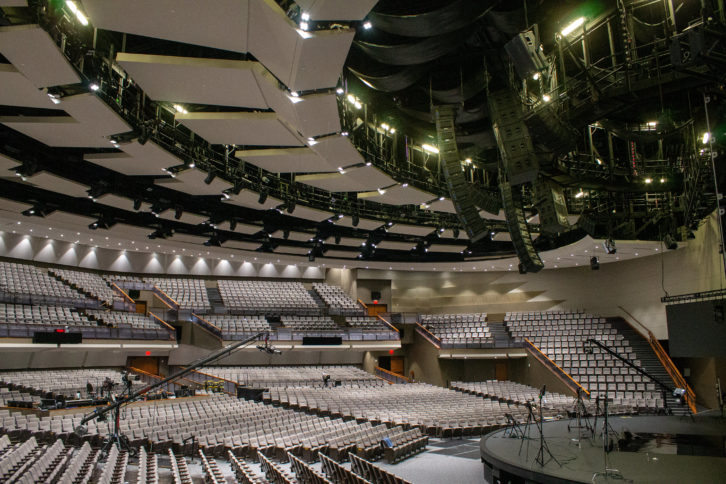 The audio overhaul also included new low-frequency components, with the former ground-stack-only system replaced by dualflown gradient cardioid arrays of five each 1100-LFC low frequency control elements for uniform dispersion throughout the auditorium. Four new 1100-LFC elements placed under the stage enhance the visceral effect up front. Eight UPQ-1P loudspeakers replaced the former stage side fills, and five GALAXY 816 Network Platforms took over signal optimization and drive. The existing delay systems, comprising a combined total of 41 UPQ-1P, UPQ-2P and UPJunior loudspeakers, were tested, found to be performing perfectly, and left in service.
The audio overhaul also included new low-frequency components, with the former ground-stack-only system replaced by dualflown gradient cardioid arrays of five each 1100-LFC low frequency control elements for uniform dispersion throughout the auditorium. Four new 1100-LFC elements placed under the stage enhance the visceral effect up front. Eight UPQ-1P loudspeakers replaced the former stage side fills, and five GALAXY 816 Network Platforms took over signal optimization and drive. The existing delay systems, comprising a combined total of 41 UPQ-1P, UPQ-2P and UPJunior loudspeakers, were tested, found to be performing perfectly, and left in service.
According to Brandon Conn, sound is now uniformly excellent throughout, but the subtle differences allow worshippers to select their preferred experience. “People who are musically inclined and want the stereo image will sit more toward the middle,” he says, “where those who want direct energy from the stage will congregate toward the front. And those who want it just a bit quieter will go to the back, but with no sacrifice in the fullness of the music or speech intelligibility.”
“I love the way the LYON and LEOPARD system allows us to deliver energy and clarity at many different volume levels,” adds Director of Live Production Broadcast Systems Jason Aulds. “Because of our many different types of events, and our desire to mix with dynamics at each event, we can swing 20 dB or more within the music portion of worship and not affect the integrity of the mix. And we are equally happy with what it offers for spoken word and our theatre productions.”
All nine Gateway Church campuses are equipped with Meyer Sound systems, with most satellite locations updated to LEO Family systems based on LEOPARD compact line arrays.
In the heart of Music Row in Nashville, the non-denominational Belmont Church, is now streaming through Belmont.TV due to COVID19, and making use of new augmented arrays outfitted by Spectrum Sound, Nashville. Once home to Amy Grant and Michael W. Smith (and considered The Birthplace of Contemporary Christian Music) Belmont Church certainly fits the artists’ contemporary style of worship and high bar for sonic expectations.
From its beginnings in 1911 as a revival tent meeting hall, the church officially broke ground in 1915, and 100+ years later they are still at the same location. The 900-seat contemporary church underwent a complete audio system renovation to the church’s main sanctuary sound reinforcement system, recording studio, and broadcast audio-for-video infrastructure. New d&b audiotechnik A-Series form the heart of the sound reinforcement system for the main sanctuary, which was last updated 20 years ago.
David A. Terry co-founder of the music production company, Sodium Glow LLC, is a music producer, mix engineer, mastering engineer, and oversees all technical aspects of the church as well as co-leads the Worship and Arts department there. “Before I became a full-time studio guy, I did a lot of live sound for various artists, from small venues to 20,000 seat arenas,” says Terry who has attended Belmont Church since 1992. I was heavily involved in the PA install in 1998 and again in 2020. “The old PA at the church was clinging to its dying breath. I had to use gaffer’s tape, tin foil, and paper clips to keep it functional for a couple years while we researched different options for the upgrade.”
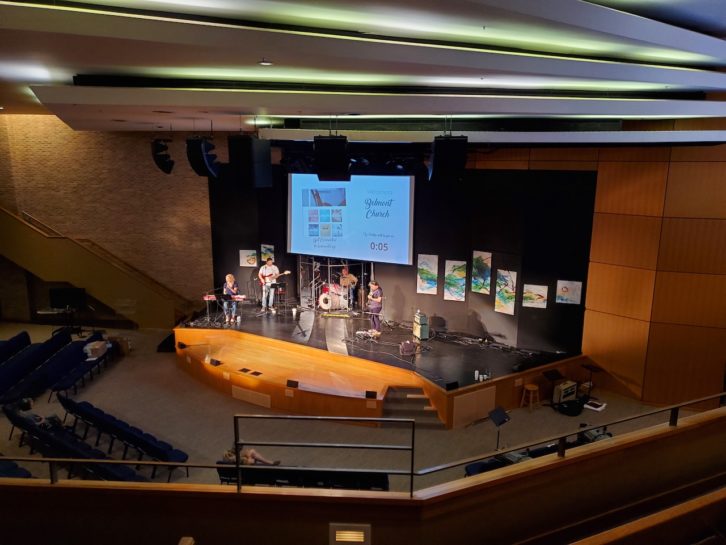 “It was time,” states Ken DeBelius, System Integration Sales Manager, Spectrum Sound of the upgrade for the historic room. “As far as the room and interior design of the space, although it feels small, it does have a nice intimate setting. The geometric room layout posed significant challenges for a loudspeaker system design that would provide appropriate coverage uniformity to all the seating planes. The main concerns of the room were the asymmetric layout of the main floor seating around the stage, and a large, steep raked balcony, which not only shadowed significant portions of the main floor, but the balcony area itself is also asymmetric. A line array solution was out of the question; the room wasn’t nearly large enough to justify, and line arrays would create unacceptable sightline issues. That left a point source loudspeaker solution, still not ideal, particularly with obtaining the considerable vertical coverage needed, and how it would look overall rigging-wise.
“It was time,” states Ken DeBelius, System Integration Sales Manager, Spectrum Sound of the upgrade for the historic room. “As far as the room and interior design of the space, although it feels small, it does have a nice intimate setting. The geometric room layout posed significant challenges for a loudspeaker system design that would provide appropriate coverage uniformity to all the seating planes. The main concerns of the room were the asymmetric layout of the main floor seating around the stage, and a large, steep raked balcony, which not only shadowed significant portions of the main floor, but the balcony area itself is also asymmetric. A line array solution was out of the question; the room wasn’t nearly large enough to justify, and line arrays would create unacceptable sightline issues. That left a point source loudspeaker solution, still not ideal, particularly with obtaining the considerable vertical coverage needed, and how it would look overall rigging-wise.
While a working point source design was still on the drawing board, DeBelius had the opportunity to audition the A-Series augmented array, designed to bridge the gap between line array and point source. d&b’s ArrayCalc software verified it would not only cover the room appropriately but would meet the SPL requirements while minimizing the impact to sightlines. The design included the use of ArrayProcessing, which delivers optimization of an array’s tonal balance and level distribution over the entire defined coverage area, front to back.
“My ‘must have’ list included even coverage in all seating positions across the frequency spectrum, excellent sound quality, and integration into our existing recording/broadcast studio and streaming system,” Terry said. “I absolutely love the d&b design philosophy and the sound of their loudspeakers. Because we have line of sight challenges in some seating areas, we wanted to use a speaker with as small a vertical footprint as possible. The A-Series was perfect for our application both in physical size and desired coverage. After I looked over the specs, we agreed with Spectrum’s recommendation to go with the A-Series.”
Because of the coronavirus pandemic, the church has not had a live service with a congregation since the install was completed but has put the loudspeaker system through its paces with a small ensemble as well as prerecorded music for its streaming service, and were able to experience the coverage and sound quality in action.
The d&b A-Series system is comprised of 4 Main flown clusters, each consisting of 2 x ALi60 and 1 x ALi90 cabinets for a total of 12 boxes. 2 x Yi-SUBs center flown cardioid subwoofers, 2 x 21S under stage floor subwoofers, 8 x 5S front fills, 8 x 5S under balcony fills, and 10D and 30D amplifiers round out the d&b system.
Rock Bridge Community Church hosts six Georgia locations making it easy to be part of this contemporary worship-style church. Five of Rock Bridge’s venues deploy an L-Acoustics A Series constant curvature line source sound system, calibrated to near-identical sound thanks to the use of the manufacturer’s new M1 measurement tool suite
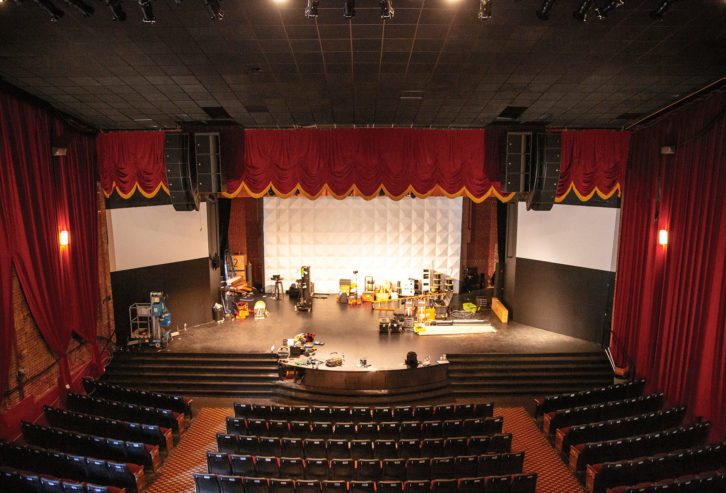 “The L-Acoustics A Series is a very cohesive system,” says Steele Beaty of Skylark Audio Video, the Oklahoma City-based integrator that designed and installed the PA for all five worship spaces. “The Wide boxes have a 30-degree vertical pattern, and the Focus has a 10-degree vertical pattern. Between them, we have the tools we need to fill a challenging venue like the Wink Theatre, where the balcony is 105 feet long, and the main floor is 95 feet long, but the entire venue is only 56 feet wide. It’s the very definition of a ‘shotgun’ room, and that’s why we chose to fly left and right arrays of five A15 Focus enclosures over one A15 Wide. Plus, the A15 enclosures have the Panflex adjustable waveguides that let us narrow the pattern width to 70 degrees, which also gives us a +2dB boost in the high frequencies. So not only do we avoid getting any energy on the walls, but we accomplish it without using any DSP. A traditional line source array simply can’t do what we were able to accomplish at the Wink with the L-Acoustics A Series medium-throw line source array.”
“The L-Acoustics A Series is a very cohesive system,” says Steele Beaty of Skylark Audio Video, the Oklahoma City-based integrator that designed and installed the PA for all five worship spaces. “The Wide boxes have a 30-degree vertical pattern, and the Focus has a 10-degree vertical pattern. Between them, we have the tools we need to fill a challenging venue like the Wink Theatre, where the balcony is 105 feet long, and the main floor is 95 feet long, but the entire venue is only 56 feet wide. It’s the very definition of a ‘shotgun’ room, and that’s why we chose to fly left and right arrays of five A15 Focus enclosures over one A15 Wide. Plus, the A15 enclosures have the Panflex adjustable waveguides that let us narrow the pattern width to 70 degrees, which also gives us a +2dB boost in the high frequencies. So not only do we avoid getting any energy on the walls, but we accomplish it without using any DSP. A traditional line source array simply can’t do what we were able to accomplish at the Wink with the L-Acoustics A Series medium-throw line source array.”
“The large balcony was the really difficult part,” adds John David Boreing, Rock Bridge Community Church Director of Strategic Initiatives whose portfolio at the church includes facilities and production. “With the previous sound system, the balcony was looking at the top of the line array and didn’t get any low end from the floor-mounted subs. It was a tough room to get proper coverage for. The new A15-KS21 combo fixed that immediately.”
From an installation standpoint, the manageable speakers helped with navigating a narrow footprint and many tightly turning staircases. “It was impossible to get a modern lift in there, and the ceiling isn’t structured, so the reduced weight and compact form factor of the A Series literally allowed us to get it in and get it hung,” he says.
The Wink Theatre installation, whose design was done using Soundvision modeling software, also made use of the new M1 suite, a comprehensive set of measurement tools from L-Acoustics. “We were able to measure the performance of all of the A15 speaker systems in one venue and create a consistent contour that we applied to all of the church’s locations,” says Beaty. “We were able to make them sound as identical to each other as humanly possible.”
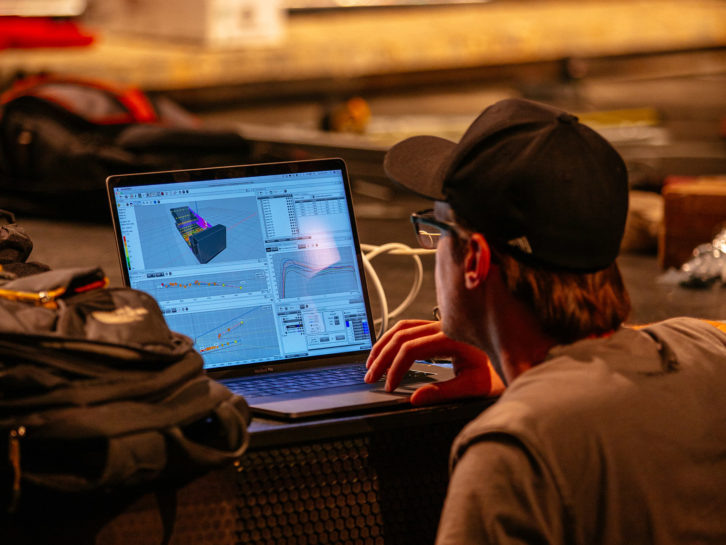 One of the major benefits of the M1 platform is that it is a force multiplier. With a single microphone, users can measure all relevant systems at multiple locations in the room, then make timing and EQ choices that are best for the room average, while being able to see the effect of any move on any location individually, or as an average. The ability to analyze data like this is pivotal in creating consistency not only in the measured room but also from venue to venue for system consistency and homogeneity.
One of the major benefits of the M1 platform is that it is a force multiplier. With a single microphone, users can measure all relevant systems at multiple locations in the room, then make timing and EQ choices that are best for the room average, while being able to see the effect of any move on any location individually, or as an average. The ability to analyze data like this is pivotal in creating consistency not only in the measured room but also from venue to venue for system consistency and homogeneity.
“Now that the pandemic restrictions have finally been relaxed a bit on worship services, everyone is really enjoying the new sound at the Wink Theatre, which is better than ever,” Boreing says.



